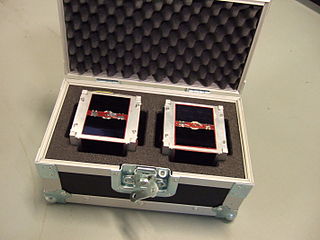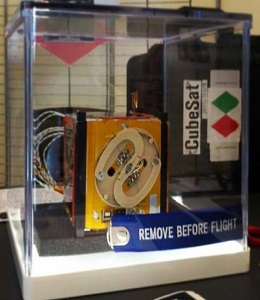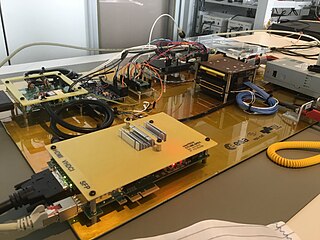
A CubeSat is a class of miniaturized satellite based around a form factor consisting of 10 cm (3.9 in) cubes. CubeSats have a mass of no more than 2 kg (4.4 lb) per unit, and often use commercial off-the-shelf (COTS) components for their electronics and structure. CubeSats are put into orbit by deployers on the International Space Station, or launched as secondary payloads on a launch vehicle. As of August 2021, more than 1,600 CubeSats have been launched.
The Space Test Program (STP) is the primary provider of spaceflight for the United States Department of Defense (DoD) space science and technology community. STP is managed by a group within the Advanced Systems and Development Directorate, a directorate of the Space and Missile Systems Center of the United States Space Force. STP provides spaceflight via the International Space Station (ISS), piggybacks, secondary payloads and dedicated launch services.

AAUSAT-II, is the second student-built CubeSat built and operated by students from Aalborg University in Denmark. It was launched 28 April 2008 05:53:51 UTC from Satish Dhawan Space Centre in India on a Polar Satellite Launch Vehicle (PSLV) launch vehicle. AAUSAT-II carries a gamma radiation sensor.
AeroCube-3 is a single-unit CubeSat which was built and is being operated by The Aerospace Corporation, at El Segundo, California. It is the third AeroCube picosatellite, following on from AeroCube-1, which was lost in a launch failure in 2006, and AeroCube-2 which was successfully launched in 2007 but failed immediately after launch. Compared to its predecessors it contains several improvements in its infrastructure, including a redesigned power system, replacing the older system which was responsible for the loss of AeroCube-2. Its development was funded by the United States Air Force Space and Missile Systems Center, at Los Angeles Air Force Base.
HawkSat-1 was a single-unit CubeSat which was built and is being operated by the Hawk Institute for Space Sciences (HISS), Pocomoke City, Maryland. It is based on a Pumpkin Inc. CubeSat kit, and carries a technology demonstration payload, primarily as a proof of concept mission, testing command, data and power subsystems, as well as solar panels and communications.

SwissCube-1 is a Swiss satellite operated by École Polytechnique Fédérale de Lausanne (EPFL). The spacecraft is a single unit CubeSat, which was designed to conduct research into nightglow within the Earth's atmosphere, and to develop technology for future spacecraft. It has also been used for amateur radio. It was the first Swiss satellite to be launched.

This article documents notable spaceflight events during the year 2019.

This article documents notable spaceflight events during the year 2018. For the first time since 1990, more than 100 orbital launches were performed globally.
Technology Education Satellite (TechEdSat) is a successful nano-sat flight series conducted from the NASA Ames Research Center in collaboration with numerous universities. While one of the principal aims has been to introduce young professionals and university students to the practical realm of developing space flight hardware, considerable innovations have been introduced. In addition, this evolving flight platform has tested concepts for Low Earth Orbit (LEO) sample return, as well as planetary nano-sat class mission concepts.

e-st@r is a miniaturised satellite built by the Politecnico di Torino. It is a 1U CubeSat design with a 10 cm side and a mass not exceeding 1.33 kg.

NUTS-1 was a Norwegian 2U CubeSat created by the NUTS student satellite project at the Norwegian University of Science and Technology (NTNU). The satellite was developed by students from several engineering and science disciplines. It was one of three CubeSats part of the Norwegian student space program ANSAT, the other two are the CubeStar and the HiNCube. From NTNUs CubeSat projects NUTS-1 is a successor of the nCube-1 and nCube-2 projects. The mission was stopped, and the small satellite activities are continued by the Orbit NTNU student organization and the HYPSO mission from NTNU Small Satellite Lab.

OPS-SAT is a CubeSat by the European Space Agency (ESA) and it is intended to demonstrate the improvements in mission control capabilities that will arise when satellites can fly more powerful on-board computers. The mission has the objective to break the cycle of "has never flown, will never fly" in the area of satellite control. It was the first CubeSat operated directly by ESA.

BioSentinel is a lowcost CubeSat spacecraft on a astrobiology mission that will use budding yeast to detect, measure, and compare the impact of deep space radiation on DNA repair over long time beyond low Earth orbit.
The Micro-Satellite à traînée Compensée pour l'Observation du Principe d'Equivalence is a 300-kilogram (660 lb) class minisatellite operated by CNES to test the universality of free fall with a precision to the order of 10−15, 100 times more precise than can be achieved on Earth. It was launched on 25 April 2016 alongside Sentinel-1B and other small satellites, and was decommissioned around 18 October 2018 after completion of its science objectives. The final report was published in 2022.

ArgoMoon is a CubeSat that was launched into a heliocentric orbit on Artemis 1, the maiden flight of the Space Launch System, on 16 November 2022 at 06:47:44 UTC. The objective of the ArgoMoon spacecraft is to take detailed images of the Interim Cryogenic Propulsion Stage following Orion separation, an operation that will demonstrate the ability of a cubesat to conduct precise proximity maneuvers in deep space.
EQUULEUS is a nanosatellite of the 6U CubeSat format that will measure the distribution of plasma that surrounds the Earth (plasmasphere) to help scientists understand the radiation environment in that region. It will also demonstrate low-thrust trajectory control techniques, such as multiple lunar flybys, within the Earth-Moon region using water steam as propellant. The spacecraft was designed and developed jointly by the Japan Aerospace Exploration Agency (JAXA) and the University of Tokyo.

Vega flight VV01 is the maiden flight of the Vega launcher. It occurred from the Centre Spatial Guyanais (CSG) on 13 February 2012 at 10:00:00 UTC.











